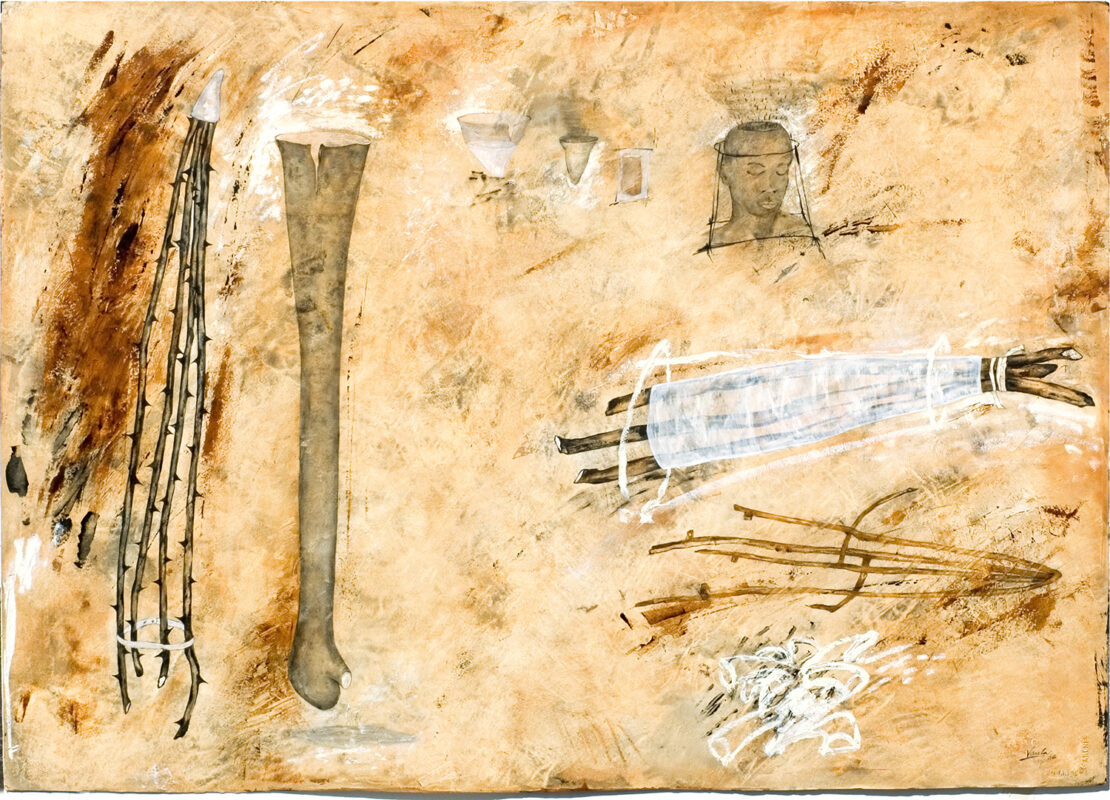He is among the most important artists in the country, known for his highly conceptual approaches, elements that are signs and symbols.
Coincidentally, just a few hours ago, a work by Fernando Varela was revealed to us, striking for its size, its pluralistic creation process, and its title "Exodus," a constant of sorts since the late 1980s, when the artist exhibited his first biblical palimpsests and collages. We find his exploration of space, the muted chromaticism of the earth, the applications of paper on the canvas. Physically, we observe a minimalist painting; conceptually, a meditation on exile and forced journey, the Holy Scriptures serving as the background and backdrop of the painting...
Almost two decades later, Fernando Varela remains unmistakable, even though he hasn't stopped inventing new forms and, beyond what those forms represent or suggest, he subverts the arrangement of symbols and, in almost every painting, creates unknown compositions and components. This is the first impression left by the exhibition "Alternative Spaces," currently on display at the District gallery in the Colonial Zone.
Without a doubt, the artist has acquired a rare capacity for recreation. We wouldn't be entirely wrong if we spoke of a state of grace, which corresponds to Fernando's faith and metaphysics, to his "spiritual alchemy." We liked that expression from María Elena Ditrén, director of the MAM, in her text.
Before continuing with the commentary on the painter's most recent artistic adventure, we would like to point out that he left the questioning of his identity far behind, which, however, the eminent art historian and director of the Montevideo Museum, Ángel Kalenberg, still pondered in a 2006 essay (1): "Apparently, Varela was nourished by the force of the tropics, but in an underlying way a community with his past can be detected, like a stubborn will to preserve his native identity..." If anything is evident, and this has been the case for several collections - let's call Fernando Varela's thematic-aesthetic series this way -, it is his ethno-anthropological commitment to the insular tropics, its migrations, its vicissitudes, its style, its people.
The Exhibition
"Alternate Spaces" surprises, convinces, and moves. Suddenly, it occurs to us that the period of "the silent word" and its swarming lyricism was a waiting period or a lyrical language of rupture... before sailing once again through the tropical seas. Such pauses in literary or artistic creation happen! Now a resurrected artist has returned to the islands and the inexhaustible metamorphoses, where from a bundle of thorny stems, a pirogue is built, from a pirogue, a pod is made.
Furthermore, a playful Fernando Varela appeared who, without betraying the clarity of his work that defines his craft, recreates… also in a sense of playfulness. It's not that he discards inhibitions, but rather, alongside the unabated transcendences and sublimations, an earthly shudder now manifests itself. The brain, the heart, sex—a new element—determine the human condition, and even nature. It's about life, growth, reproduction. In counterpoint are death and disappearance, symbolized by a brain, transformed "Kafka-esque" into an insect, finally into a simple linear sign. Nothing is less indulgent than these "alternative spaces," at once sparsely and intensely populated…
Often, the creatures were species of mutants, whose bodies, although differentiated into men and women, wielded spiritual force and levitation toward unknown atmospheres. Today, the individual has racial features and sex, appears native, authentic, erotic, but keeps his eyes closed, may squat, or bathe in a form/substance of amniotic fluid. Is the new "Varelian" man yet to be born? Creolization advances: the frontispiece features Caribbean islands and countries, while the character, motionless and asleep, is contained by a linear architecture and structure. The prosaic reader thinks of a gigantic sieve. Could they be mistaken? Or does this interpretation belong to the plurality of readings prompted by most of the works?
And the landscape, carnal, sensual, and forest-like, makes its entrance. Here, lyrical and transparent, immaterial and insinuating, vertical and parallel, unfolds Fernando Varela's jungle.
This truly marvelous pictorial ode to Antillean nature, to what they call the rainforest, is one of his last paintings. In fact, it formalizes and places in an ecological context whitish objects, structures, prostheses, wrappings, openly defined "things" suggested in other spaces. This unique and harmonious landscape will continue to bear cultural fruit.
"Alternative Spaces" presents paintings, drawings, and a small sculpture/installation—three faces on a pedestal—at District. In addition, interactive activities—workshops, discussions, and a guided tour—accompany this fantastic exhibition in every sense of the word.

